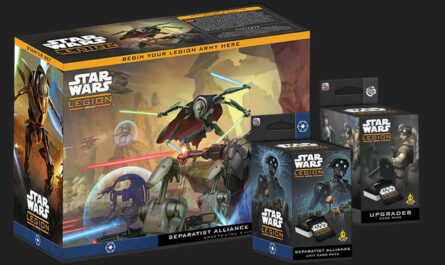In 2016, screenwriters Tony Gilroy and Chris Weitz brought a breath of fresh air to the Star Wars franchise with Rogue One. Gone were the lightsabers, family drama, and aristocratic disputes. Instead, the focus shifted to the “nobodies” in a universe dominated by VIPs. This time, background characters stepped into the spotlight, while the franchise’s icons were relegated to the sidelines. For Star Wars: Legion, this film is a blessing. It serves as a perfect reference to translate the mentality and expertise of Rebel soldiers into game mechanics. There was nothing to invent—just to replicate. However, it seems the designers of Legion didn’t watch the same movie as the rest of the world…
Welcome to the second part of “What’s Your Problem, Rebel Alliance?”, a series of articles analyzing the game design mistakes made during the creation of the Rebel Alliance in Star Wars Legion. This series is categorized under Carte blanche, meaning it represents a subjective—but well-argued—perspective aimed at providing constructive criticism.
The Pathfinders: Rogue One’s Shock Unit
With a look inspired by American soldiers during the Vietnam War, the Pathfinders are the men who join Jyn and her crew on Scarif to steal the Death Star plans. Cassian sums up their expertise in a single sentence:
“Make ten men feel like a hundred.”
— Cassian Andor, Rogue One: A Star Wars Story
This line should have been the cornerstone for designing their profile in Star Wars: Legion. As infiltrators, their mission was to create diversions by detonating key areas of Scarif. Their actions were so effective that the Empire, caught in a panic, deployed AT-AT walkers to respond to a threat they couldn’t fully gauge.
Translating this concept of men who appear far more formidable than they truly are into Star Wars: Legion was entirely feasible. In fact, FFG had a mechanic ready-made for the Pathfinders. Unfortunately, it wasn’t assigned to these special forces but instead found its way to Agent Bane.
The mechanic in question is the one described on his 3-pip command card, I Make the Rules Now. This allows Cad Bane to skip deployment and instead place three Bane tokens on the battlefield: one marking his actual position, one representing a bomb, and the last being a decoy. Isn’t that the very essence of the Pathfinders?

Apparently not, at least according to FFG’s decisions. Instead, the keyword Infiltrate was given to this shock unit. A reasonable choice, but not enough, as it neglects the crucial element of hidden information. There’s no way to obscure the Pathfinders’ position or to outwit your opponent with clever misdirection.
No explosions in the sky
From a mechanical perspective, the other keywords assigned to the Pathfinders aren’t absurd. Dauntless and Danger Sense aptly capture the fearless nature of these soldiers. But these are all defensive keywords. There’s no reference to their expertise in causing panic within the Empire. No suppressive abilities or explosives. Yes, you read that right—the Pathfinders lack any heavy weaponry or effects to simulate the use of TNT…

Destabilization: The Rebel Objective
In the first part of What’s Your Problem, Alliance?, I discussed the duality between the Empire and Rebel Alliance factions. They were designed as reciprocal counterparts. This reciprocity extends not just to unit profiles but also to their “tribal token”—the game mechanic that each faction is most attuned to.
For the Empire, it’s the Aim token. For the Rebels, it’s the Dodge token. Empire units naturally gain access to keywords that synergize with Aim tokens, such as Precise, Lethal, and Marksman. Meanwhile, Rebels benefit from keywords like Agile, Defensive Stance, and Jar’Kai Mastery.
Pause. Wait a second. Would you associate the Dodge token with the Rebel Alliance? Is this really the token that best defines them?
A Rebel is someone who stands against the established order. The Rebel Alliance is an organization constantly working to destabilize the Empire, throw a wrench in its machinery, paralyze its operations, weaken its foundations, and ultimately sink the entire ship. To the Empire, they are nothing less than terrorists—a constant nuisance aimed at disrupting their plans by any means necessary.

In my opinion, the Suppression token should have been the Rebel Alliance’s tribal token—not the Dodge token. Rebel keywords should have revolved around suppression, and new keywords or effects interacting with that yellow token should have been created. This would have set the Alliance apart as the faction capable of adapting and thwarting their opponent’s strategies.
Conclusion – Part Two
In this second article, I wanted to discuss the overarching identity of the Rebel Alliance in Star Wars: Legion. I did so by highlighting the case of the Pathfinders, as they embody the DNA of the Rebels that we see on the big screen. While some units are faithfully adapted—like Han Solo with his command cards—it is disappointing to play as the Alliance today. It feels like performing a song riddled with wrong notes. You can recognize the melody, but in practice, it’s an entirely different tune.
Nowadays, when I want to field an army built around disruption, suppression, and misdirection, I choose the Empire with Cad Bane. Not the Alliance. And as a Rogue One fan, this frustrates and pains me.
In the next part of What’s Your Problem, Alliance?, I’ll delve deeper into the concept of tribal tokens and explore their impact not just on faction identity but on gameplay itself. Read part III.

Find Star Wars: Legion players
Join your country’s SWL Discord community and connect with players nearby.



